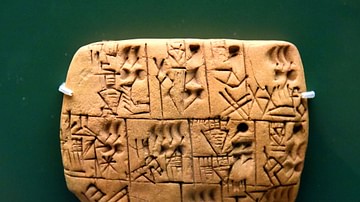Review

| Rating: | |
|---|---|
| Title: | In the Land of Ninkasi: A History of Beer in Ancient Mesopotamia |
| Author: | Tate Paulette |
| Audience: | General Public |
| Difficulty: | Medium |
| Publisher: | Oxford University Press |
| Published: | 2024 |
| Pages: | 392 |
"In the Land of Ninkasi" is a narrative that delves into the ancient beer-making practices of Mesopotamia. It offers a detailed, archaeology-based exploration of this historical craft. Intended for researchers, students, and casual readers alike, it balances academic depth with enjoyable storytelling, making it a compelling read for anyone interested in history, archaeology, or the origins of brewing.
In the Land of Ninkasi: A History of Beer in Ancient Mesopotamia by Tate Paulette offers a straightforward introduction to its subject matter. It provides a comprehensive insight into the ancient practice of Mesopotamian beer-making. Each chapter is structured around a specific question, thoroughly answered with the support of a wealth of archaeological and literary sources. The abundance of archaeological evidence and primary references renders an element of authenticity to the narrative. The author begins a chapter with a brief anecdote, making the content engaging and encouraging readers to move forward. Paulette’s vivid imagination is evident throughout, as he brings the ancient world of beer to life, making the book an enjoyable and immersive read from the outset.
The work transports readers into the world of ancient beer production, providing clear and detailed content that touches on every aspect of the process—from the ingredients used to the people who consumed it. It aims to explore the role of experimental archaeology in understanding beer production. It offers a broad overview of the brewing process in a civilization renowned for its many innovations. Additionally, the book opens new avenues for future research, providing ample material for further exploration. While it covers all facets of the topic, it remains grounded by acknowledging the challenges in drawing definitive conclusions about practices from 5,000 years ago.
The narrative’s approach is firmly rooted in archaeology, reflecting the author’s background as an archaeologist and expertise in history. Paulette is Associate Professor of History at North Carolina State University. While the ancient literary sources may invite skepticism due to their varying interpretations by various scholars, Paulette expertly corroborates different sources with archaeological evidence. This blend of literary and archaeological research offers a comprehensive understanding of the ancient beer-making process, providing a balanced perspective on how such knowledge has been uncovered.
While the book is a valuable resource for researchers, scholars, and students of history or archaeology due to its extensive research and references to both recent and ancient archaeological findings, it is equally suitable for casual readers. Its engaging style and thorough exploration of beer-making make it a perfect companion for anyone interested in the subject, perhaps even while enjoying a beer. The inclusion of a beer recipe toward the end—designed for both homebrewing enthusiasts and those interested in knowing the chemical composition—serves as a fitting conclusion to the reader’s journey, rounding out a fascinating exploration of ancient brewing techniques.
Because of these points, this book is highly recommended. The writing style is smooth and easy to follow, ensuring that readers find exactly what they are looking for. The imaginative narratives and storytelling are the most enjoyable aspects, as they brought the ancient world to life entertainingly and vividly. The book is successful in transporting the reader to a distant civilization, still thriving and sharing in the enjoyment of a drink cherished for millennia. It creates a connection across time, making ancient Mesopotamia feel unexpectedly present and alive.
About the Reviewer
Cite This Work
APA Style
Kushwaha, S. (2024, November 27). In the Land of Ninkasi: A History of Beer in Ancient Mesopotamia. World History Encyclopedia. Retrieved from https://www.worldhistory.org/review/495/in-the-land-of-ninkasi-a-history-of-beer-in-ancien/
Chicago Style
Kushwaha, Sneha. "In the Land of Ninkasi: A History of Beer in Ancient Mesopotamia." World History Encyclopedia. Last modified November 27, 2024. https://www.worldhistory.org/review/495/in-the-land-of-ninkasi-a-history-of-beer-in-ancien/.
MLA Style
Kushwaha, Sneha. "In the Land of Ninkasi: A History of Beer in Ancient Mesopotamia." World History Encyclopedia. World History Encyclopedia, 27 Nov 2024, https://www.worldhistory.org/review/495/in-the-land-of-ninkasi-a-history-of-beer-in-ancien/. Web. 28 Apr 2025.



